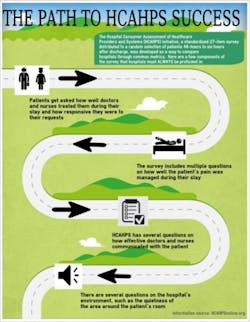In the process of conducting research for my most recent feature, I came to realize one thing about how hospitals across this country are trying to improve the patient-centered culture.
It’s not about high-definition TVs, better food, temperature-controlled rooms, and a quiet night’s rest. Those are components that people will focus on, but when it comes down to it, there is one thing that stands above all. Communication. That’s where it’s at.
Patients want doctors and nurses to communicate at a level they understand. That’s where not only where can hospital leaders find success in getting evaluating through the Hospital Consumer Assessment of Healthcare Providers and Systems (HCAHPS) initiative, but in creating a better atmosphere for their patients.
For those who are unaware, HCAHPS is the standardized 27-item survey distributed to a random selection of patients 48-hours to six weeks after discharge. It was created as a way to compare hospitals through common metrics. It is tied to reimbursement from the Value-Based Purchasing program, accounting for 30 percent of a hospital’s total performance score (TPS) for FY 2013.
While on the hunt for good sources for this story, one of my favorite people to talk with was Rhonda Scott, R.N., Ph.D., chief nursing officer (CNO) at the Atlanta-based, 953-bed Grady Memorial Hospital. Dr. Scott serves as the patient satisfaction initiative champion at Grady, which actually expects to lose a significant amount of money to poor scores.
Grady has gone into overdrive in trying to improve the patient experience and turn those scores around. For instance, leaders at the hospital have invested in more channels on the TV, better food options, and more private, high-tech friendly rooms. However, above all else, the hospital has focused on improving communication, specifically through its nurses.
Nurses, Scott and others say, are the ones who are in contact with the patient the most. “Nursing care is the only reason they’re in the hospital. If it can be done in an outpatient center or a physician’s office, it would be done,” she says. There’s a reason a nurse like Scott is heading up this initiative.
Thus, in an effort to improve communication between nurses and patients, Grady invested in mobile phones for nurses from Amcom (Eden Prairie, Minn.). These phones keep the patient in constant contact with the nurses, at the click of a button. Other leaders I talked with had a similar philosophy when it came to nursing communication, increasing hourly rounds and such.
Doctors are of course held under the same scrutiny. Check out this recent research report from the University of Missouri, which found that increased use of computerized clinical decision support systems (CDSSs) led to greater patient dissatisfaction.
It seems odd that something designed to ultimately help the patient and make their lives safer would be disparaged, no? Well researchers discovered that patients felt the CDSSs took away from their “face-to-face time” with physicians.
That’s right. Communication.
In fact, one of the researchers declared that patients weren’t comfortable with physicians’ use of technology in general. “Anything physicians or nurses can do to humanize the process may make patients more comfortable,” surmises Victoria Shaffer, author of the research and an assistant professor of health sciences and psychological sciences at the University of Missouri.
I don’t believe that can you separate technology and communication issues. As Grady proves, you can use one to improve the other. I also love what James Merlino, a patient satisfaction guru at Cleveland Clinic, a non-profit academic medical center in Cleveland, Ohio, is doing with analytics. He’s taking patient data to better understand how populations of patients react to their experience and then use it to improve processes. Other technologies, such as digital records,
Yet I do understand the point of what Shaffer and others are saying. It’s all about communication. It’s about looking that patient in the eye, making sure they’re informed and that they understand. This human element is where the path to patient satisfaction begins.
On second thought, I should have had that third item listed first!
I’ll leave it at this little story. My girlfriend emailed her doctor friend about a specific condition. He responded by sending her information, a lot of it contained medical jargon that she didn’t understand. What did he do? Translated it. That’s Comm. 101 and that’s patient satisfaction at its finest.
Thoughts on patient satisfaction? Please feel free to respond in the comment section below or on Twitter by following me at @HCI_GPerna



